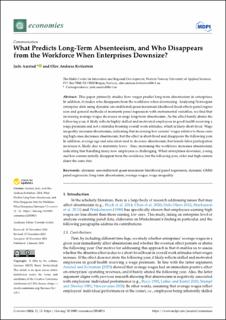| dc.description.abstract | This paper primarily studies how wages predict long-term absenteeism in enterprises. In addition, it studies who disappears from the workforce when downsizing. Analyzing Norwegian enterprise data using dynamic unconditional quasi-maximum likelihood fixed-effects panel regression and general methods of moments panel regression with instrumental variables, we find that increasing average wages decreases average long-term absenteeism. As the effect barely abates the following year, it likely reflects highly skilled and motivated employees in good health receiving a wage premium and not a stimulus boosting overall work attitudes, which is likely short-lived. Wage inequality increases absenteeism, indicating that increasing low earners’ wages relative to those earning high ones decreases absenteeism, but the effect is short-lived and disappears the following year. In addition, average age and education tend to decrease absenteeism, but female labor participation increases it, likely due to maternity leave. Also, increasing the workforce increases absenteeism, indicating that handling many new employees is challenging. When enterprises downsize, young and low earners initially disappear from the workforce, but the following year, older and high earners share the same fate. | en_US |

